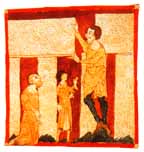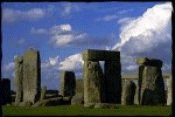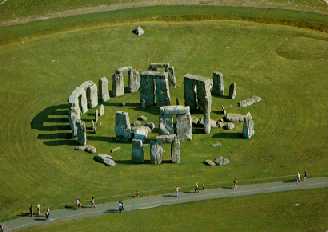| Legend
1: |
Legend 1 states that the devil was involved
in the building. He bought stones of an elderly woman from Ireland, and
used his "magic" to transport them to their current spot on the Salisbury
plain in England. He then set them up. He got egotistical, and bets that
no one in the nearby village would be smart enough to count all the stones.
When asked, a local friar said "that is more than thee canst tell",
which means "that is more than can be told. That was the correct answer.
Now the devil was mad, because his plan was foiled. He picked up a stone,
and threw it as hard as he could at the friar. The friar thought quickly,
and bounced it off of his heel. His heel was so hard that it caused a dent
in the stone. To this day the stone is called the "Heel Stone", named by
John Aubrey. |
| Legend
2: |
| Legend 2 states that dancing giants
were circling around on the Salisbury plain. Suddenly and without reason,
they were turned into stones. This legend was once popular because of the
shape of the megaliths somewhat resembles the shape of giants holding hands. |
 |
| Legend
3: |
The legend of King Arthur provides another
story of the construction of Stonehenge. It is told by the twelfth century
writer, Geoffrey of Monmouth, in his History of the Kings of Britain that
Merlin brought the stones to the Salisbury Plain from Ireland. Sometime
in the fifth century, there had been a massacre of 300 British noblemen
by the treacherous Saxon leader, Hengest. Geoffrey tells us that the high
king, Aurelius Ambrosius, wanted to create a fitting memorial to the slain
men. Merlin suggested an expedition to Ireland for the purpose of transplanting
the Giant's Ring stone circle to Britain. According to Geoffrey of Monmouth,
the stones of the Giant's Ring were originally brought from Africa to Ireland
by giants (who else but giants could handle the job?). The stones were
located on "Mount Killaraus" and were used as a site for performing rituals
and for healing. Led by King Uther and Merlin, the expedition arrived at
the spot in Ireland. |
| The Britons, none of whom were giants,
apparently, were unsuccessful in their attempts to move the great stones.
At this point, Merlin realized that only his magic arts would turn the
trick. So, they were dismantled and shipped back to Britain where they
were set up as they had been before, in a great circle, around the mass
grave of the murdered noblemen. The story goes on to tell that Aurelius,
Uther and Arthur's successor, Constantine was also buried there in their
time.
|
 |
| Common
Believes |
| . A circular group of massive,
upright stones, the Stonehenge monument was once thought to have been a
type of prehistoric astronomical observatory or clock for predicting the
seasons and other astronomical events. |
| . Stonehenge's axis is pointed roughly
in the direction of the sunrise at the summer and winter solstices. Some
scientists believe that early peoples were able to foretell eclipses of
the sun and the moon by the positions of these celestial bodies in relation
to the stone monument. The site may have served as an observatory where
early rituals or religious ceremonies took place on specific days of the
year. |
 |
| . The early belief that
the monument was built as a temple for sky worship has never been definitively
proven. |
| . An another earlier notion
was that Stonehenge was connected with the Druids, a caste of Celtic priests. |